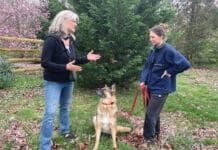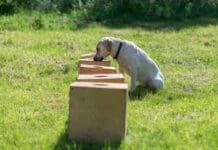Not so very long ago, trainers assumed that anyone who signed up for a basic obedience class was seeking that perfectly straight, sit-in-perfect-heel position. Classes were conducted with military precision, trainers barking commands as owners marched their dogs in a circle, jerking and popping on leashes and choke chains in order to achieve lightning-fast responses. Success was measured by speed and perfection of position, and advanced work was conducted with one goal – to show in American Kennel Club obedience competitions, earn obedience degrees, and achieve scores as close to that magic “perfect 200” as possible.
A New Training Paradigm
My, how the times have changed! A relatively few years ago, many trainers began to realize that the largest percentage of dog owners in their classes really only wanted a well-behaved companion – a trustworthy family dog. Who cared if the dog was sitting three degrees off perfect? Most owners were just happy the dog sat at all!! They couldn’t have cared less about scores in the obedience ring. Thus began a paradigm shift in the dog training world, from obedience competition training to family dog training. With that shift has come an exciting vista of advanced training opportunities and breathtakingly fun dog-related activities.

Today, the possibilities for canine recreational activities are almost endless. Mixed breed dogs, once second-class citizens in training classes, can now compete in obedience through the American Mixed Breed Obedience Registry (AMBOR) or the Mixed Breed Dog Club, and at national obedience competitions. They can also join their blue-blooded brothers and sisters in agility, herding, flyball, Frisbee, tracking, drill team, square dancing, musical freestyle, My Dog Can Do That, Canine Good Citizen Tests, animal assisted therapy programs, K9 games, tricks classes, lure coursing, (take a breath) television, advertising and movie work, water dog sports . . . There is something out there for every dog’s talents.
The Beagle who failed obedience competition because she couldn’t keep her nose off the ground can do tracking or Search and Rescue work. The Pomeranian whose owner gave up on his Companion Dog obedience degree because the dog kept running out of the ring and jumping into spectator’s laps now goes to hospitals and retirement homes and sits on laps to his heart’s content. The teen-age owner of the mellow German Shepherd/Lab mix can proudly display her Canine Good Citizen certificate on her bedroom wall. The Border Collie who . . . well, the Border Collie who used to score perfect 200s in the obedience ring can also delight in herding and penning a flock of sheep, or dancing a waltz with her owner.
Dogs who are encouraged to engage in activities that stimulate them mentally and highlight their inborn talents are less frustrated and better behaved than their less fortunate littermates who languish, bored and lonely, in neighbors’ backyards. Owners whose dogs are less frustrated and better behaved can appreciate their dogs more, enjoy engaging in activities with them, and are more likely to fulfill their social contract to provide a lifelong loving home for their canine companions. Even if taking the dog hiking or camping is the activity that best satisfies the behavioral needs of dog and owner, the new, non-competition-based classes that rely primarily on the use of positive training methods are the best approach to developing a dog with acceptable social skills while building an unbreakable bond between canine and human.
The following is a guide to the wealth of possibilities available in the world of dog training, to help you decide which activities to pursue with your furry friend. We’ve also included information to help you identify an appropriate training environment, once you’ve made your discipline decision.
Basic Training – The Foundation
Basic training is the foundation for any of the more advanced canine activities. If you are interested in pursuing the less formal doggie activities, you can start by finding a basic class whose trainer is more interested in making sure her students (both two-legged and four) have a good time while they learn than maintaining strict discipline in the canine classroom. Chances are if you are “just” looking for “good manners,” you won’t enjoy getting yelled at to jerk your dog for sitting crooked.
Once you have graduated from a basic training class you are ready to explore the big wide world of more advanced canine activities. Here are several of the many activities now available in most parts of the country.
My Dog Can Do That
A board game you play with your dog – whoever heard of such a thing? These days, more and more dog owners have, as word spreads about My Dog Can Do That. This delightful game requires the use of positive reinforcement training methods. Owners pick cards from any one of three decks, at three differing levels of difficulty. Each card describes a “trick” or behavior that the dog has to do. Examples of each level of difficulty are:
Beginner – Dog must sit still while player skips ten feet away and stops.
Intermediate – Dog must lie down, roll over completely, then stand up.
Advanced – Dog must retrieve a toy and drop it in a basket five feet from player.
Owners can use treats, praise, hand signals and other verbal or body language cues as needed, but no anger or force; no pushing, pulling, jerking, or yelling. You can play it as a family game, with each member of the family taking turns drawing a card and working with the dog. You and your dog can play against your friends and their dogs. Or you can take part in the increasing number of MDCDT matches and tournaments that are being held around the country.
Be forewarned – dog owners who are serious about this game have already purchased it and are practicing all of the behaviors on the cards with their dogs in preparation for competition. You’d better hurry if you want to catch up! Animal shelters and training clubs are starting to offer MDCDT competitions as fund raisers, and rumor has it that there are going to be 25 official competitions held in various locations around the country this summer.
The game can be purchased at some pet stores, and through J and J Dog Supplies, (800) 642-2050.
Agility
It’s an obstacle course for dogs, complete with tunnels, jumps, a teeter-totter, and several other items to challenge your dog’s agility ability. Dogs of all shapes and sizes love it – experienced dogs run an entire course by themselves while the owner stands in the middle of the ring. Three of the four organizations that sponsor competitions welcome mixed breed participation, so there’s no excuse – anyone can play!
Since it is one of the more senior “nouveau” dog activities, almost every town has at least one trainer or dog club that offers an agility class. Some animal shelters and dog parks have permanent agility courses set up so dogs (accompanied by their owners, of course) can practice at will. If your dog walks fallen logs across swollen creeks and leaps tall buildings in a single bound, this just might be the activity for you.
Some organizations offering information on agility and agility competition include:
American Kennel Club (AKC)
5580 Centerview Dr. Suite 200
Raleigh, NC 27606
(919) 233-9780
United Kennel Club
100 E. Kilgore Rd.
Kalamazoo, MI 49001
(616) 343-9020
North American Dog Agility Council
HCR 2 Box 277
St. Maries, ID 83861
U. S. Dog Agility Association
P.O. Box 850955
Richardson, TX 75085-0955
(972) 231-9700
Flyball
You have to see this one to believe it. Flyball is a hurdle relay race for a team of four dogs of any heritage. Each dog in turn jumps four jumps, spaced ten feet apart. At the end of the jumps is a flyball box. When the dog touches the pedal on the front of the box a tennis ball shoots out. The dog catches the ball and goes back over the four jumps to the owner waiting at the starting line. Then the next dog goes. The team that finishes first wins.
Flyball is a very competitive sport, and great fun to watch. Dogs with an affinity for retrieving tennis balls adore this game. Owners who are serious about it can help their dogs earn a range of titles, from Flyball Dog (FD) – for earning 20 points in competition, to Flyball Grand Champion (FGD Ch.) – for earning 30,000 points.
In North America, flyball is governed by the North American Flyball Association. A copy of official rules is $10; other information is free of charge.
NAFA, Inc.
1002 E. Sanuel Ave.
Peoria Heights, IL 61614
Herding
When you think of sheep or cattle dogs, you tend to visualize Australian Shepherds and Border Collies. But the list of dogs that can be taught to herd includes multi-purpose breeds with herding ancestors way back in their bloodlines, and mixed-breed dogs with some herding blood. And the list of breeds that are officially designated as herding dogs is much longer than most people think – some 30 breeds, including the Rottweiler, Tibetan Terrier and the Samoyed. Multi-purpose dogs that can herd includes another dozen or so, including such unlikely breeds as the Kerry Blue Terrier, Poodle, Soft-Coated Wheaten Terrier, and Schipperke.
But, of course, herding is the perfect outlet for the high-energy Border Collie and the other intense herding breeds, as it makes full use of their extreme intelligence and obsessive herding behaviors. Watching the miracle of a trained herding dog working a flock of sheep helps us understand and appreciate those obsessive behaviors – such as rounding up the kids or staring for hours at the cat – that can drive us crazy.
Several organizations promote herding events. They include:
Australian Shepherd Club of America
6091 Hwy 21
Bryan, TX 77803-9652
(409) 778-1082
American Herding Breed Association
AHBA Secretary
1548 Victoria Way
Pacifica, CA 94044
U. S. Border Collie Handler’s Assoc.
Francis Raley, Secretary
2915 Anderson Ln.
Crawford, TX 76638
(254) 486-2500
AKC Test/Trial Program
51 Madison Ave.
New York, NY 10010
Frisbee
We’ve all watched them in awe – on beaches, in parks, and during half-time at football games – those incredibly athletic dogs that leap eight feet off the ground and catch a Frisbee in mid-air. Frisbee is an activity you don’t even have to go to a class for – all you need is a dog who loves to jump and retrieve, and, of course, a Frisbee. Even dogs who aren’t naturals at it can learn to play Frisbee, and there are loads of resources – books, information available from Frisbee Clubs, and Internet web sites. For those who like to get serious, there are Frisbee competitions almost everywhere, up to and including national canine Frisbee championships.
Alpo, a major sponsor of these contests, will send you a booklet on how to train your dog to perform Frisbee dog basics like the chest vault, front flip, and back roll, in order to prepare for Frisbee competition!
Alpo Canine Frisbee Disc Champ.
Peter Bloeme, Director
4060 – D Peachtree Rd., Suite 326M
Atlanta, GA 03019
Animal Assisted Therapy
When all is said and done, we value our dogs most highly for the unconditional love and loyal companionship they give us. A large and very generous group of dog and owner teams share their time and love with others who cannot be with their own pets because circumstance require them to be in a hospital, nursing home, or other facility that normally doesn’t allow animals.
Therapy dogs can be any breed, mix, size shape or color, as long as they are well-behaved, can tolerate disturbing events like rolling wheelchairs, falling crutches, and patients who don’t always behave like other people, and who enjoy being the center of attention. There are national organizations that provide certification for therapy dogs, and many local humane societies offer therapy programs. These programs always welcome new volunteers because the demand for animal-assisted therapy is so high.
Imagine how it would feel to be deprived, long-term – maybe forever – of the touch of your dog’s soft fur, or the caress of her warm tongue. Those on the human side of the animal-assisted therapy equation talk of miracles – of non-responsive patients who move, even speak for the first time in months when a therapy dog greets them; of faces that light up when a furry friend arrives. With all that our dogs give to us, it is only right that we give some of that back to others.
The two primary organizations that certifiy therapy dogs in the U.S. are:
Delta Society, Pet Partners
P.O. Box 1080
Renton, WA 98057
(800) 869-6898
Therapy Dogs International
6 Hilltop Rd.
Mendham, NJ 07945a
(201) 543-0888
Musical Freestyle
Affectionately known as “Dancing With Dogs,” Musical Freestyle (AKA Canine Freestyle) the newest doggie sport is most akin to a combination of ballroom dancing and pairs figure skating. People and dogs dance together to music of the person’s choosing, in a routine choreographed to complement the dog’s personality and abilities – it can be short and simple, or longer and more complex.
While many owners do musical freestyle with their dogs for the sheer joy of it, there are also freestyle competitions and exhibitions, which are increasing in number as the sport catches on. These are always great crowd pleasers, and the emotional bond between dog and owner that is so obvious in the routines often brings tears to the eyes of the observers. If you see it you will be hard-pressed not to be inspired to start dancing with your own dog.
Musical Canine Sports International oversees the freestyle sport in the U.S. and Canada. For information or to join, contact:
Sharon Tutt
Treasurer/Membership
1665 Parkview Place
Surrey, B. C.
Canada, V4N 1Y8
(604) 581-3641
Freestyle videotapes can be purchased from:
Pat Ventre
Ventre Advertising, Inc.
P.O. Box 350122
Brooklyn, NY 11235
(718) 332-8336
For information on upcoming freestyle competitions and demonstrations:
Joan Stevenson
22 Roanoke Rd.
Matawan, NJ 07747
(908) 566-3812
Tracking
A tracking dog follows the scent trail left by a human being (or other animal) that has passed along a particular route. Tracking can be done as a hobby (for fun), as a sport (to earn titles), as part of a serious effort to save human and animal lives through Search and Rescue work, and in law enforcement as police K9 units track criminal suspects. The ability of a dog to follow scent trails that are invisible to the human nose seems almost magical to us, but we know that any canine nose is thousands of times more sensitive than ours. Tracking is really pretty ho-hum stuff to a dog. The challenge is in getting the dog to follow the scent we want them to.
Sometimes it can be pretty easy. We know of one terrier mix who taught herself to find her owner’s lost turtles. Josie has saved several turtle lives with her special, self-taught skill. It can be a humbling experience to watch a dog work a scent trail and succeed in finding the target. Tracking, like agility, has been around for quite some time, so if your dog shows nose talent, finding a trainer near you should be relatively easy.
A number of organizations offer tracking tests and trails for sport in the U.S. and Canada, including:
American Kennel Club
5580 Centerview Dr., Suite 200
Raleigh, NC 27606
(919) 233-9780
United Schutzhund Clubs of America
3810 Paule Ave.
St. Louis, MO 63125-1718
Australian Shepherd Club of America
6091 E. State Hwy. 21
Bryan, TX 78808
(409) 778-1082
American Mixed Breed Obedience
Registry (AMBOR)
P.O. Box 7841
Rockford, IL 61126-7841
Canadian Kennel Club
100-89 Skyway Ave., Unit 100
Etobicoke, Ontario M9W 6R4
Something For Everyone
This is by no means a complete list of all the dog activities available. If none of these appeal to you and your canine companion, check with local trainers, animal shelters, dog clubs, and the Internet to find out what others might be available. With an almost infinite variety of options, there is bound to be something for everyone. There is no excuse for being a couch potato when your dog is ready, willing, and eager to do something, anything fun, as long as you’ll do it with her.
Thanks to Andrea Sirott of Berkeley, CA; and Guy and Charlotte Covner, tracking dog trainers from Windsor, CA for their help with this article.





